 Guess who took this picture of Jupiter? Hubble? Keck? A well equipped amateur here on Earth? Nope, it was taken by the HiRISE camera on board the Mars Reconnaissance Orbiter. The picture was taken from orbit around Mars.
Guess who took this picture of Jupiter? Hubble? Keck? A well equipped amateur here on Earth? Nope, it was taken by the HiRISE camera on board the Mars Reconnaissance Orbiter. The picture was taken from orbit around Mars.
Continue reading “Looking at Jupiter, From Mars”
Looking Down on Mars Pathfinder
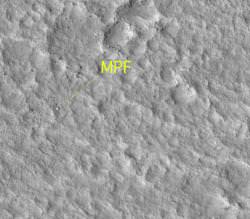 Remember the Mars Pathfinder? That plucky little rover that crawled around the surface of Mars back in 1997? Well, the new Mars Reconnaissance Orbiter’s powerful camera has found it again on the Martian terrain. It’s time to relive those days of early Martian exploration.
Remember the Mars Pathfinder? That plucky little rover that crawled around the surface of Mars back in 1997? Well, the new Mars Reconnaissance Orbiter’s powerful camera has found it again on the Martian terrain. It’s time to relive those days of early Martian exploration.
Continue reading “Looking Down on Mars Pathfinder”
NASA Panel Will Investigate Mars Global Surveyor’s Disappearance
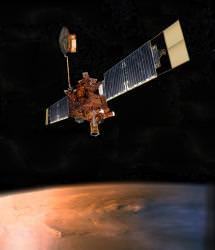 Although it lasted years longer than anyone ever expected, the disappearance of NASA’s Mars Global Surveyor spacecraft is still a mystery the agency wants to investigate. The agency has created an internal review board to review the spacecraft’s final days and recommend any new processes or policies that could improve future spacecraft.
Although it lasted years longer than anyone ever expected, the disappearance of NASA’s Mars Global Surveyor spacecraft is still a mystery the agency wants to investigate. The agency has created an internal review board to review the spacecraft’s final days and recommend any new processes or policies that could improve future spacecraft.
Continue reading “NASA Panel Will Investigate Mars Global Surveyor’s Disappearance”
Mars Rovers Learn Some New Tricks
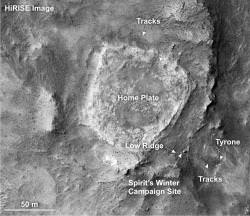 Consider this for a moment. NASA’s Mars Exploration rovers are nearing their third anniversary of crawling around the surface of Mars. Spirit arrived on January 3rd, 2004, and Opportunity showed up 21 days later. And they were only supposed to be usable for a few months.
Consider this for a moment. NASA’s Mars Exploration rovers are nearing their third anniversary of crawling around the surface of Mars. Spirit arrived on January 3rd, 2004, and Opportunity showed up 21 days later. And they were only supposed to be usable for a few months.
Continue reading “Mars Rovers Learn Some New Tricks”
Finding Buried Craters on Mars
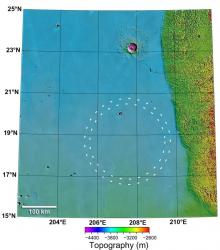 Many photographs have been taken of Martian landscapes, but now spacecraft are looking beneath the surface to see what’s buried underground. Researchers used instruments on board ESA’s Mars Express orbiter to detect ancient impact craters beneath the smooth surface of Mars’ northern hemisphere. Some of these craters were formed billions of years ago, but have been resurfaced and buried by lava flows and sediments from winds and water.
Many photographs have been taken of Martian landscapes, but now spacecraft are looking beneath the surface to see what’s buried underground. Researchers used instruments on board ESA’s Mars Express orbiter to detect ancient impact craters beneath the smooth surface of Mars’ northern hemisphere. Some of these craters were formed billions of years ago, but have been resurfaced and buried by lava flows and sediments from winds and water.
Continue reading “Finding Buried Craters on Mars”
Detailed Ice Layers Revealed on Mars
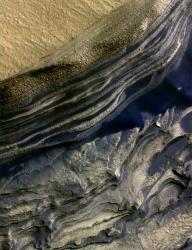 Amazing new images taken by NASA’s Mars Reconnaissance Orbiter show layers of ice deposits near the Martian poles. The polar layers are at the top of the image, while the darker materials at the bottom might have been deposited as sand dunes. The Martian ice has mixed with dust to give it the reddish hue.
Amazing new images taken by NASA’s Mars Reconnaissance Orbiter show layers of ice deposits near the Martian poles. The polar layers are at the top of the image, while the darker materials at the bottom might have been deposited as sand dunes. The Martian ice has mixed with dust to give it the reddish hue.
Continue reading “Detailed Ice Layers Revealed on Mars”
New Spurts of Water Discovered on Mars
Just when you thought Mars was dead, it goes and surprises you. New images released from the Mars Global Surveyor shows new gullies on the surface of Mars that formed within the last 7 years. The shape and path taken down the slope suggests that they were carved by rushing liquid water. It’s possible that there are quantities of liquid water underneath the surface, which can escape to the surface from time to time. Even though Mars can get cold, researchers think that water spurting out of the ground could last long enough to carry debris down the slope of a hill before freezing solid.
Continue reading “New Spurts of Water Discovered on Mars”
NASA’s Spirit Rover… From Space
NASA’s Mars Reconnaissance Orbiter is peering down at spacecraft on the surface of Mars again. This time it’s turning its optics on the Spirit Rover and the two Viking Landers that reached the surface of Mars in 1976. Scientists understand the terrain from ground level, so these high resolution images will help them understand the context of what the rovers and landers see around them. The view is so detailed that scientists can identify specific rocks that were seen by the Viking landers more than 30 years ago.
Continue reading “NASA’s Spirit Rover… From Space”
Podcast: HiRise View of Mars
If you want to get a good view of something, you’ll want a big telescope, or you want to get close. NASA has decided to both, equipping its new Mars Reconnaissance Orbiter with the largest spacecraft telescope ever built, and then flying it closer to Mars than any previous spacecraft. This telescope is called the High Resolution Imaging Science Experiment, and returning the most detailed images ever seen of the Martian surface. Dr. Alfred McEwen from the University of Arizona is the Principal Investigator on the HiRise instrument, and he joins me from Tuscon Arizona.
Continue reading “Podcast: HiRise View of Mars”
Flood of New Hi-Resolution Mars Images Released
NASA’s newest visitor to the Red Planet, the Mars Reconnaissance Orbiter, has been taking a torrent of photographs at the highest resolution ever captured. The spacecraft’s High Resolution Science Imaging Experiment (HiRISE) has taken almost 100 images since its main science mission began on November 7. The image with this story shows sculptured sand dunes inside Russell Crater on Mars, but an 15 additional images are featured on the HiRISE website.
Continue reading “Flood of New Hi-Resolution Mars Images Released”
